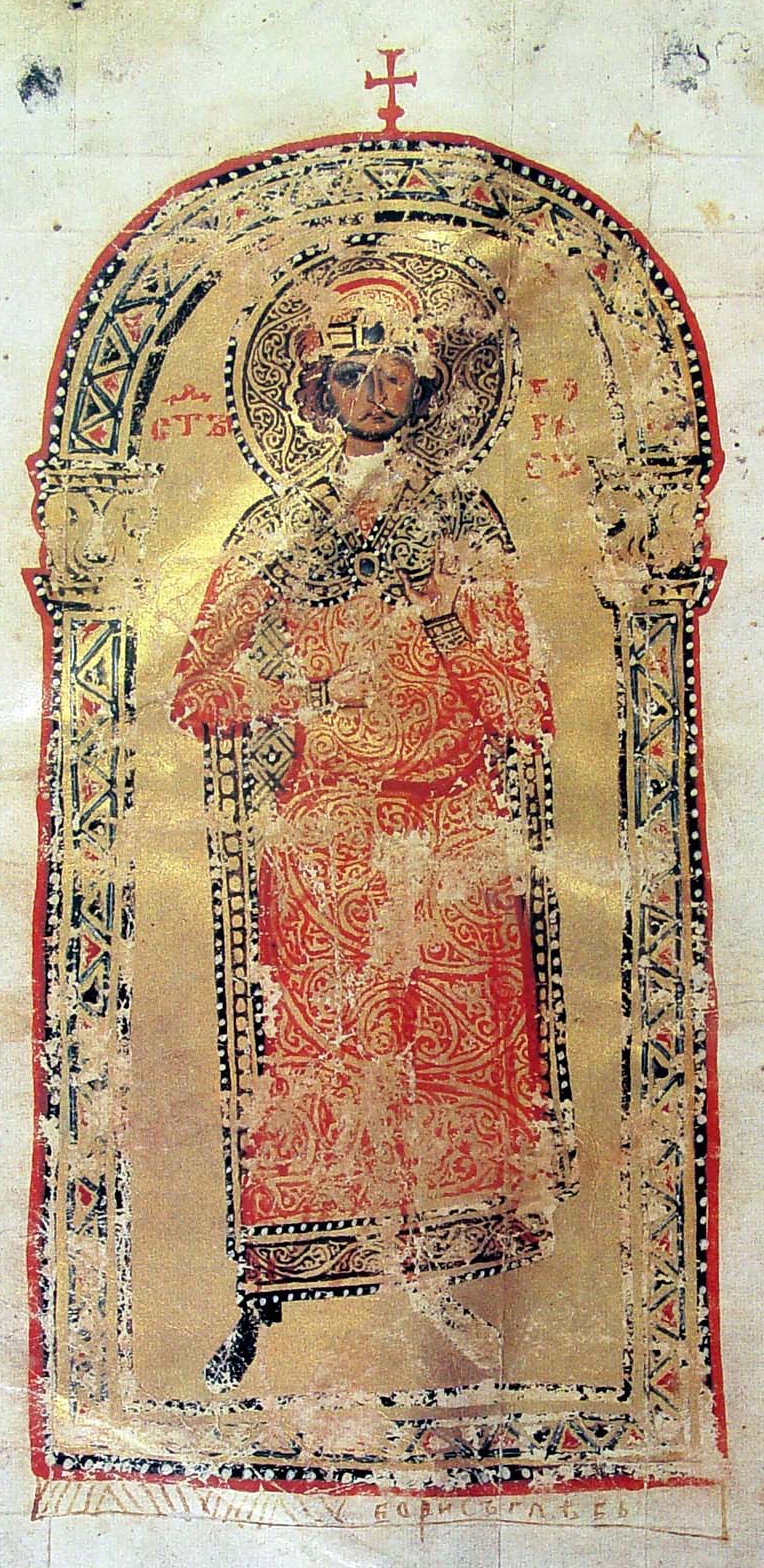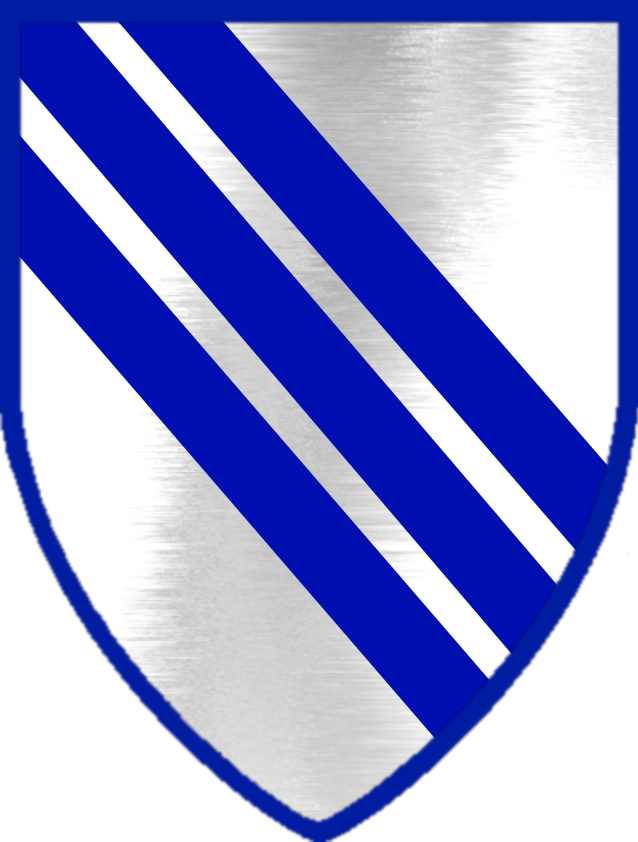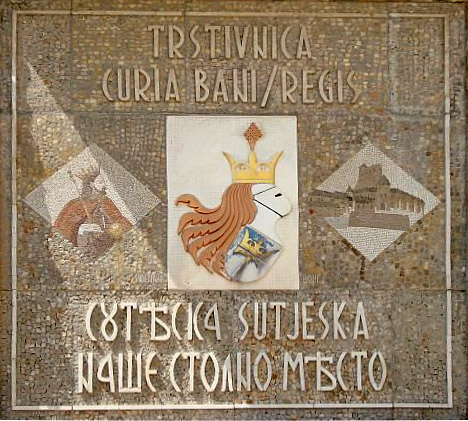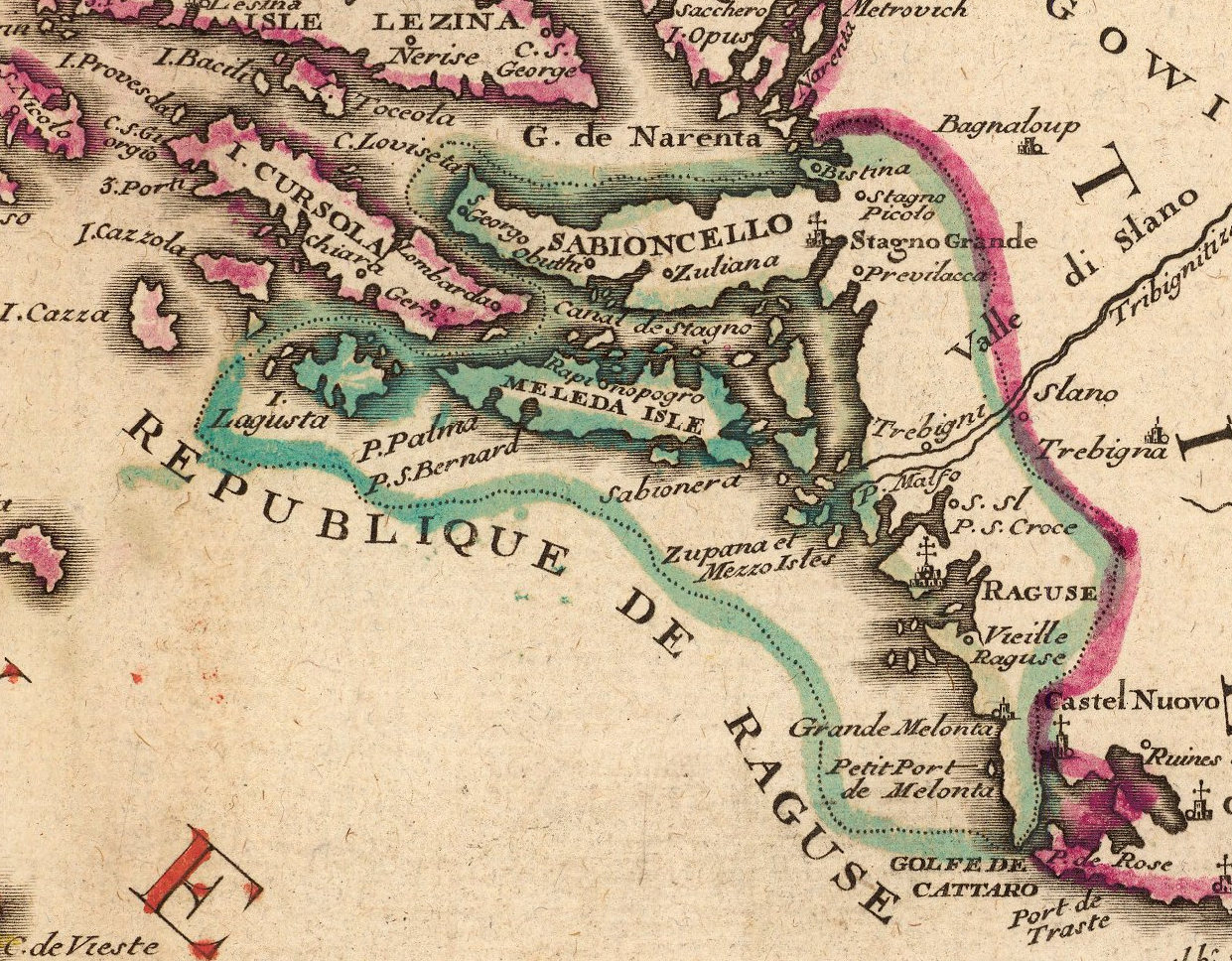|
Vukmir Zlatonosović
Vukmir Zlatonosović ( sr-Cyrl, Вукмир Златоносовић; died 1424) was a duke from the noble Zlatonosović family that ruled the area of Usora in the Kingdom of Bosnia. He was a participant in the conspiracy against Knez Pavle Radinović, hatched by Sandalj Hranić and King Stjepan Ostoja, which resulted in Pavle's assassination at Parena Poljana near royal court in Sutjeska in 1415. According to the conspiratorial plan, the town of Olovo should have been handed over to Vukmir, but that did not happen. He fell ill in 1424. Thus, at the beginning of the aforementioned year, Sandalj Hranić asked for help from the people of Dubrovnik to send a doctor to Vukmir. The request was repeated once again in October, and the people of Dubrovnik took on the expenses of two hundred perper, which was necessary for the treatment. Since then, Vukmir is not mentioned in the records, and it is considered that he died in the same year. He was succeeded by his brother Vukaši ... [...More Info...] [...Related Items...] OR: [Wikipedia] [Google] [Baidu] |
Usora (zemlja)
Usora (, ) was important '' zemlja'' (; feudalna oblast ) of the medieval Bosnian state, first banate and later kingdom, although it also had some periods outside its jurisdiction and royal authority, when it was connected with neighboring banates of Slavonia, or Mačva at times. The administrative seat of this ''zemlja'' was Srebrenik, which also served as residence for its rulers for entire period of existence of the medieval Bosnian state. It took its name from the river Usora. Etymology The name of the land of Usora derives from the eponymous river, which runs through its territories for approximately 80 kilometers, in direction south-southwest to north-northeast, and spills into the river Bosna just south of town of Doboj. Geography and location Usora was the northernmost Bosnian land (''zemlja''), occupying very fertile Pannonian Plain, and its geographical location roughly correspond to modern-day Northern Bosnia gravitating toward Posavina. Its territory stretch ... [...More Info...] [...Related Items...] OR: [Wikipedia] [Google] [Baidu] |
Kingdom Of Bosnia
The Kingdom of Bosnia ( / Краљевина Босна), or Bosnian Kingdom (''Bosansko kraljevstvo'' / Босанско краљевство), was a medieval kingdom that lasted for nearly a century, from 1377 to 1463, and evolved out of the Banate of Bosnia, which itself lasted since at least 1154. King Tvrtko I of Bosnia, Tvrtko I (r. 1353–91) acquired portions of western Serbia and most of the Adriatic coast south of the Neretva River. During the late part of his reign, Bosnia became one of the strongest states in the Balkans, Balkan Peninsula. However, feudal fragmentation remained important in Bosnia and the Bosnian nobility held significant power, exercising it at the Stanak meetings where members deliberated on matters such as Royal elections, election of the new king or queen and coronations, foreign policy, sale or cession of territory, contracting and signing treaties with neighboring countries, and military issues. The Ottoman Empire Ottoman conquest of Bosnia a ... [...More Info...] [...Related Items...] OR: [Wikipedia] [Google] [Baidu] |
Knez (title)
A , also , ''knjaz'' or (), is a historical Slavic title, used both as a royal and noble title in different times. It is usually translated into English as 'prince', 'king' or 'duke', depending on specific historical context and the potentially known Latin equivalents at the time; the word was originally derived from the common Germanic ('king'). Feminine forms of the word may be divided into two groups: * "Princess", be it princess consort (wife of a reigning prince), princess regnant (reigning princess ''suo jure''), or princess regent (reigning on behalf of an underage prince, usually her son after her husband's death) ** Belarusian: ''kniahinia'' (княгіня) ** Bulgarian and Russian: () ** Slovene, Serbo-Croatian, and Macedonian: (in Serbian and Macedonian Cyrillic: ) ** Ukrainian: (княгиня) * "Daughter of the prince" ** Belarusian: ''kniazioŭna'' (князёўна) ** Russian: (; the son of a ''knyaz'' is ' ( in its old form). ** Ukrain ... [...More Info...] [...Related Items...] OR: [Wikipedia] [Google] [Baidu] |
Pavle Radinović
Pavle Radinović, sometimes Radenović, ( sr-Cyrl, Павле Радиновић; floruit, fl. 1371–d. 1415), was one of the most powerful Bosnians, Bosnian Nobility, nobleman under Tvrtko I (r. 1377–1391), Stephen Dabiša of Bosnia, Dabiša (r. 1391–1395), Jelena Gruba (r. 1395–98), Stephen Ostoja of Bosnia, Ostoja (r. 1398–1404), Tvrtko II (r. 1404–1409) and Ostoja again (r. 1409–1418). He was a Knez (title), knez and the head of Pavlović noble family, Radinović-Pavlović noble family, a powerful magnate clan whose initially possessions spread from central to eastern Bosnia, gravitating around the Prača (river), Prača - Miljacka river axis, between the Krivaja (Bosna), Krivaja Drina and the Bosna (river), Upper Bosna rivers, with the seat in Borač (fortress), Borač and Pavlovac (fortress), Pavlovac between Pale-Prača, Prača and Rogatica, and also held mines in Olovo and Fojnica. Pavle was assassinated near Royal court in Sutjeska on 24 August 1415, by his c ... [...More Info...] [...Related Items...] OR: [Wikipedia] [Google] [Baidu] |
Sandalj Hranić
Sandalj Hranić Kosača ( cyrl, Сандаљ Хранић Косача; 1370 – 15 March 1435) was a powerful Bosnian nobleman whose primary possessions consisted of Hum, land areas between Adriatic coast, the Neretva and the Drina rivers in Bosnia, and served the court as the ''Grand Duke of Bosnia'' sometime between 1392 and his death in 1435, although the first mention as a Grand Duke in sources comes from 16 June 1404. He was married three times, but had no children. After his death, he was succeeded by his nephew Stjepan Vukčić Kosača. His father was Hrana Vuković. Rise of Sandalj As the head of the House of Kosača, Sandalj Hranić succeeded his uncle Vlatko Vuković in 1392. In 1403, Radič Sanković led the attacks on Dubrovnik during the Bosnian-Ragusan War in the name of King Stephen Ostoja. Sandalj Hranić captured and blinded Radič, and held him in prison until his death in 1404. When King Ladislaus of Naples sold his rights to the kingdom of Da ... [...More Info...] [...Related Items...] OR: [Wikipedia] [Google] [Baidu] |
Stjepan Ostoja
Stephen OstojaHis name in Bosnian is rendered Stjepan Ostoja (), while in Croatian it is Stjepan Ostoja. In Serbian, he is called Stefan Ostoja (). ( sh-Latn-Cyrl, separator=" / ", Stjepan Ostoja, Стјепан Остоја; died September 1418) was King of Bosnia from 1398 to 1404 and from 1409 to 1418. Family connections He was a member of the House of Kotromanić, most likely son of Vladislaus and brother of King Tvrtko I. When duke Hrvoje Vukčić in 1416 died, King Ostoja divorced his old wife Kujava from the house of Radinović and married Hrvoje's widow Jelena Nelipčić the next year.John Van Antwerp Fine, Bosnian Institute; ''The Bosnian Church: Its Place in State and Society from the Thirteenth to the Fifteenth Century'', Saqi in association with The Bosnian Institute, 2007 Jelena Nelipčić was the sister of Prince Ivan III Nelipić from the Croatian noble Nelipić family. That way Ostoja inherited most of Hrvoje's lands. Rise to power Ostoja was brought to pow ... [...More Info...] [...Related Items...] OR: [Wikipedia] [Google] [Baidu] |
Royal Court In Sutjeska
Royal Court in Sutjeska was a medieval Bosnian court, residence, and administrative seat of the Bosnian king, from mid-fourteenth to mid-fifteenth century, located in present-day Kraljeva Sutjeska, Bosnia and Herzegovina. The compound consisted of several buildings, chapel, and the nucleus of what would later become Kraljeva Sutjeska Franciscan Monastery. History The court in Trstionica (present-day Kraljeva Sutjeska) was established by Ban of Bosnia, Stjepan II Kotromanić. Location The court remains are located in present-day Kraljeva Sutjeska, Bosnia and Herzegovina. The remains of the royal court are situated on the small prominence next to the Kraljeva Sutjeska Franciscan friary and church. This prominence is called Grgurevo. The site is separated in two distinct parts by small Urva brook. The court and its chapel are mentioned in 1378 in the charter of the King Tvrtko I. The court chapel (church) was dedicated to Saint Gregory the Miracle-Worker (''Sveti Grgur Čudot ... [...More Info...] [...Related Items...] OR: [Wikipedia] [Google] [Baidu] |
Olovo
Olovo ( sr-cyrl, Олово) is a town and municipality located in the Zenica-Doboj Canton of the Federation of Bosnia and Herzegovina, an entity of Bosnia and Herzegovina. It is situated about 50 kilometers northeast of the capital city of Sarajevo and is located on the road between Sarajevo and Tuzla. History The town Olovo was first mentioned in the year 1382 under the name "Plumbum" (Latin for lead). The word ''olovo'' in Bosnian means ''lead'', and the name was given to the town for its well-known lead ore deposits. Olovo stands on the Sarajevo–Tuzla highway M18, and is located 50 km northeast of Bosnia and Herzegovina's capital city of Sarajevo. Olovo is located in the Zenica-Doboj Canton. Recently, there have been attempts to make Olovo part of the Sarajevo Canton; however, the town remains within the Zenica-Doboj Canto Middle Ages Since the Middle Ages, the town has been well known for its lead ore deposits, and Olovo was a mining town during medieval Bosnian ... [...More Info...] [...Related Items...] OR: [Wikipedia] [Google] [Baidu] |
Republic Of Ragusa
The Republic of Ragusa, or the Republic of Dubrovnik, was an maritime republics, aristocratic maritime republic centered on the city of Dubrovnik (''Ragusa'' in Italian and Latin; ''Raguxa'' in Venetian) in South Dalmatia (today in southernmost Croatia) that carried that name from 1358 until 1808. It reached its commercial peak in the 15th and the 16th centuries, before being conquered by Napoleon's First French Empire, French Empire and formally annexed by the Kingdom of Italy (Napoleonic), Napoleonic Kingdom of Italy in 1808. It had a population of about 30,000 people, of whom 5,000 lived within the city walls. Its motto was "'", a Latin phrase which can be translated as "Liberty is not well sold for all the gold". Names Originally named ' (Latin for "Ragusan municipality" or "community"), in the 14th century it was renamed ' (Latin for ''Ragusan Republic''), first mentioned in 1385. It was nevertheless a Republic under its previous name, although its Rector was appointed b ... [...More Info...] [...Related Items...] OR: [Wikipedia] [Google] [Baidu] |
Vukašin Zlatonosović
Vukašin Zlatonosović ( sr-Cyrl, Вукашин Златоносовић; died 1430) was a duke from the noble Zlatonosović family, which governed the ''Zemlja (feudal Bosnia), zemlja'' Usora (zemlja), Usora in the Kingdom of Bosnia. In primary sources, he is mentioned for the first time in 1399, as a witness in the charter of King Stjepan Ostoja. After the death of his brother Vukmir Zlatonosović, Vukmir, he remained the only representative of this house. Although second grade nobility, in his time he was one of the most influential magnates in the Kingdom of Bosnia. When a conflict broke out between Radoslav Pavlović Radinović, Radoslav Pavlović and the Republic of Dubrovnik in 1430, the Republic asked for help from Tvrtko II of Bosnia, Tvrtko II, who replied that he had to consult with Duke Vukašin Zlatonosović and Duke Sandalj Hranić. Until June 1430, it was considered that the inclusion of Vukašin in the conflict would be beneficial. In the fall of the same ye ... [...More Info...] [...Related Items...] OR: [Wikipedia] [Google] [Baidu] |






